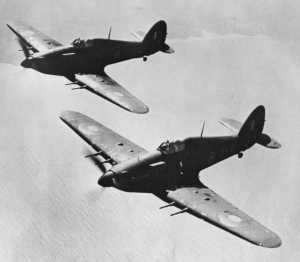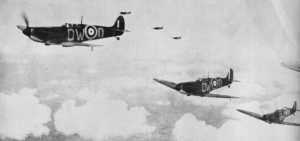British Aces of World War Two
The Battle of Britain
By Stephen Sherman, Dec. 2003. Updated July 5, 2011.
After the fall of France and the Low Countries in June 1940, Hitler looked next to conquer the defiant British, still holding out under Sir Winston "We shall never surrender" Churchill. In 1940, Britain was still the Ruler of the Waves; the Royal Navy was the best in the world; and the English Channel lay between Germany's continental conquests and the British Isles.
Persuaded by promises from Luftwaffe Reichsmarshal Herman Goering, Hitler decided to bomb the British into submission, before attempting a cross-Channel invasion. With the aid of hindsight, it seems a ludicrous proposition; the limits of airpower having been amply demonstrated in Korea and Vietnam. But in 1940, fresh from the blitzkrieg conquests of Poland, Denmark, Norway, the Low Countries, and France, and still utterly pleased with the fearsome impact of their Stukas, Heinkels, and Messerschmitts in those campaigns, Hitler gave Goering the go-ahead to reduce the English resistance from the air. The Wehrmacht's transports stayed at anchor.
The Germans made these decisions despite the poor condition of the Luftwaffe to wage such a conflict:
- German twin-engine bombers did not have the range or bombload capacity required.
- Luftwaffe forces were worn down from recent campaigns.
- Most importantly, German fighters lacked the range to provide adequate fighter coverage for the bombers.
On August 13, the Luftwaffe launched an all-out attack on the RAF airfields, code-named Adlertag ("Eagle Day"). Poor weather and fierce RAF fighter defense hampered the Luftwaffe bombers from doing much damage. At a cost of 13 fighters, the RAF shot down 45 Luftwaffe aircraft. But the Germans continued to focus on the RAF for the next month. Frustrated by the inability to destroy the RAF, the Germans switched to night bombing of cities on September 5. This was the beginning of the Blitz; while not evident to the British people at the time, the greatest threat had passed. While the Blitz inflicted terrible casualties on the English people, the RAF continued to gather strength from this point on.
One of the great British aces of the Battle of Britain was a man with artificial legs! Douglas Bader had lost his legs while flying a Bristol Bulldog from Kenley to Woodley airfield in 1931. The doctors amputated both his legs, and Bader was not expected to survive, but he did, and with the aid of tin legs, even began flying again. He was grounded for the next several years, but after war broke out he was back in the air. He quickly rose to command 222 Squadron, and by June of 1940 was in command of 242 Squadron, the only Canadian squadron in the RAF at the time. On August 9, 1941, his luck ran out: he collided with a Bf 109, went down, and was captured by the Germans. He was imprisoned at the infamous Colditz castle. The great German ace, General Adolf Galland, cooperated in delivering to Bader a pair of artificial legs that the British air-dropped into France. Bader survived the war, was knighted in 1976 by Queen Elizabeth for his services to amputees, and passed away in 1982. Read more about Bader here.
| Top British Aces | Kills | Comment |
|---|---|---|
| James "Johnnie" Johnson | 38.0 | top WWII British ace, flew Spitfires |
| Brendon E. Finucane | 32.0 | Irish, 65 Sqn, later KIA |
| Robert Braham | 29.0 | POW June '44, night fighter, 3DSO, 3DSC |
| Robert Stanford Tuck | 29.0 | 2+ years as POW, 92 & 257 Sqns |
| F. R. Carey | 28.0 | 43 Sqn |
| J. H. "Ginger" Lacey | 28.0 | Hawker Hurricane pilot, 501 Sqn |
| Neville. F. Duke | 28.0 | |
| E. G. Lock | 25.0 | |
| B. Drake | 24.5 | 213 Sqn |
| G. Allard | 23.8 | 85 Sqn, KIA |
| Douglas Bader | 22.5 |
After the Battle, Winston Churchill said in the House of Commons "The gratitude of every home in our island, in our Empire, and indeed, throughout the world, except in the abodes of the guilty, goes out to the British airmen, who, undaunted by the odds, unwearied in their constant challenge and mortal danger, are turning the tide of world war by their prowess and by their devotion. Never in the field of human conflict was so much owed by so many to so few!"
Recommended Web sites:
Remembering the Battle of Britain
Recommended Books:
The Battle of Britain: The Greatest Air Battle of World War II, by Richard HoughSpitfire Mark II Aces 1939-41 (Osprey Aircraft of the Aces, No 12), by Alfred Price - featuring stories of ten leading Battle of Britain aces





